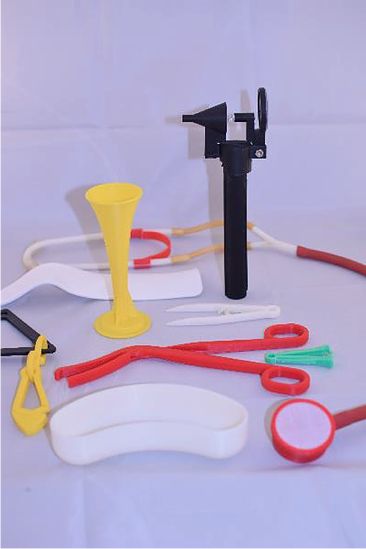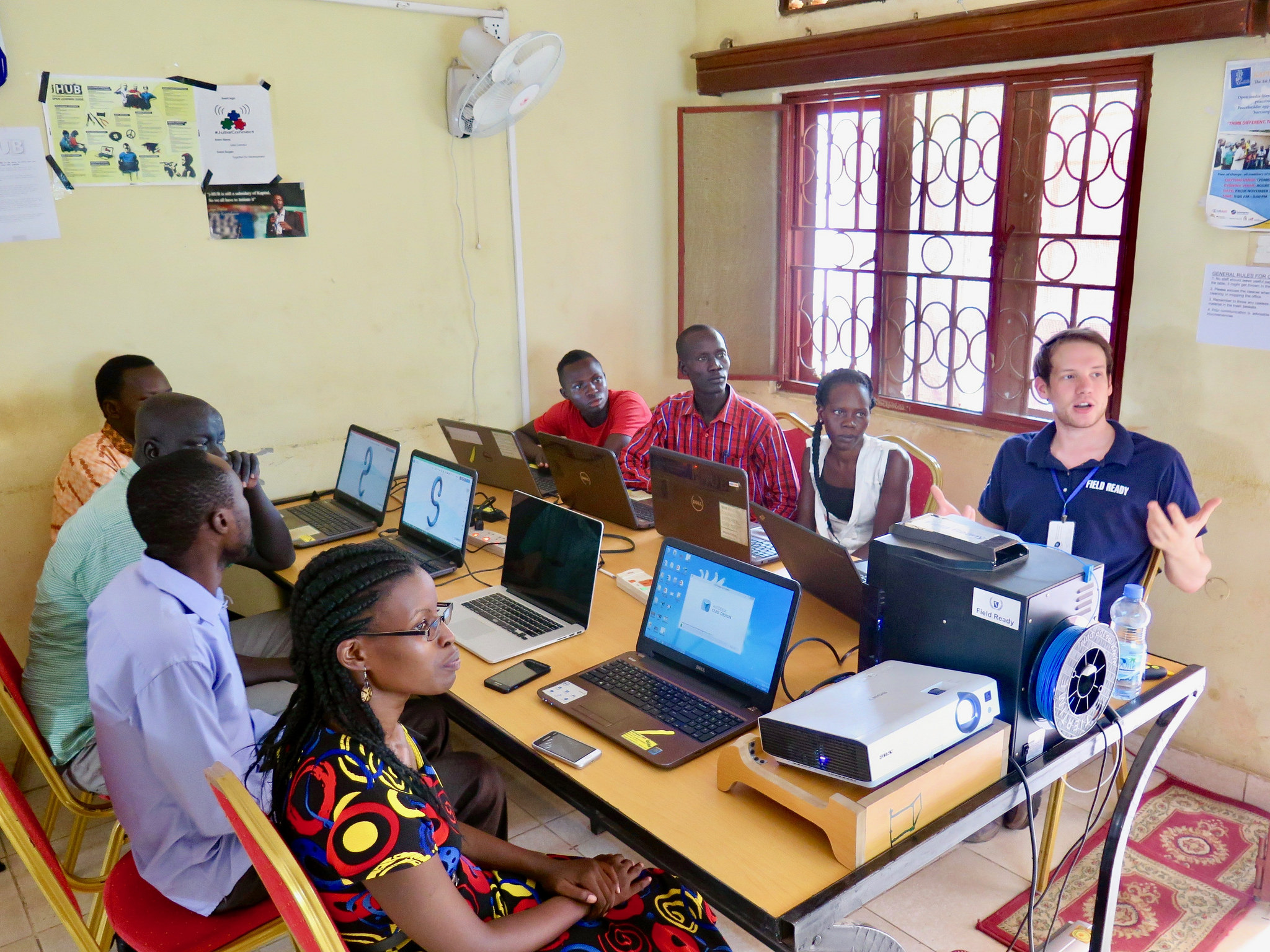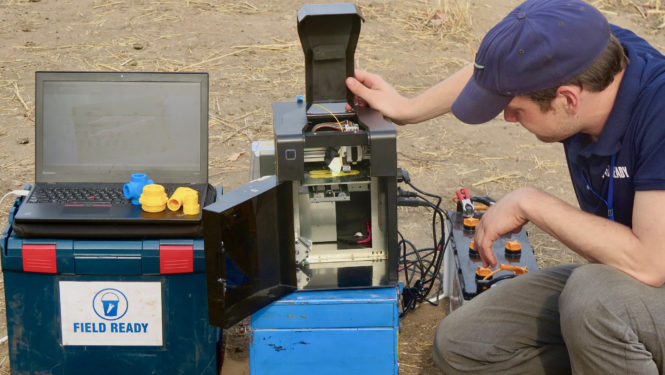Part of a series about 2017 National Week of Making.
The tipping point was the fingertips of some gloves, and they launched Dara Dotz on an unexpected journey to co-found Field Ready, a humanitarian nonprofit that uses 3D printers, laser cutters and other technologies to create critical supplies in disaster zones.
The organization has worked in countries such as Haiti, Nepal, Kenya, South Sudan and, most recently, Syria where one of their innovations led to the rescue of a mother and child from the wreckage of a collapsed building.

The Making of Field Ready
In 2012 Dara — an industrial designer by trade, a maker at heart, and a Burner to boot — went to Haiti. A massive earthquake had devastated the country two years previously, and Dara wanted to see what phase three of a disaster looked like: when the aid has arrived and rebuilding has started.
She was shocked to see crumbling buildings, non-existent infrastructure and a lack of supplies.
“They still didn’t have constant power, there were rolling power outages and there was no clean water. When I went down to the main hospital in Port-au-Prince, part of the buildings was still just hanging there as if the earthquake had just happened the day before, and you could see the doctors and nurses still buzzing around inside,” says Dara.
“The thing that really got me was the systems: A lot of the systems kept falling apart just because they were missing one piece.”
But the tipping point was the gloves of a nurse called Maeve. One night, Maeve had to deliver five babies, but she had no medical supplies left, and she needed something sterile to tie off the umbilical cords. So she took the last pair of her sterile latex gloves and cut off the tops of the fingers, potentially exposing herself to HIV-positive patients.
“That’s what completely turned me around, even about the way I see technology,” says Dara, who confesses to having been anti-technology in her student days, when she saw a CNC machine as “cheating”, showed no interest in 3D printers and preferred to do everything by hand.

Printing and Precedents
But with clamps costing around US$3.00 each in Haiti and taking up to 18 months to reach the clinic, purchasing new clamps wasn’t an option.
So the next time Dara had power and internet, she did a social media shout-out for a 3D printer, and a friend heeded her call by donating and shipping a 3D Makerbot printer. After seeking advice from local medical practitioners about what they needed, Dara then designed a clamp that could be customised and 3D-printed.
To ensure an ongoing supply of material, the clamps could also be recycled, with each woman returning her clamp at the baby’s first check-up and the hospital sterilising it, melting it down and turning it back into fresh clamps. Best of all, the clamps cost 30¢ each to make, a tenth of the normal cost.
“Imagine the possibilities. A 3D printer can now be an on-demand hospital supply catalogue, where virtually every sterile part costs the same and requires no special tooling. And you can use it as needed to make any number of objects,” she says.
But the origin story of Field Ready didn’t just involve technology; it also included training. Dara taught locals how to use the printer so they could become “creators and not victims”.
A Slow Burn
For the next year or so, Dara kept returning to Haiti as the idea for Field Ready slowly grew.
“I had no interest in setting up an organization. I just wanted to see how things worked and to get stuff done. So I kept going back and forth, and thought: ‘I think this could become something’,” says Dara.
In 2013, a chance conversation at a start-up retreat led her to Eric James, a whizz at all things operational and an expert in humanitarian aid. He was itching to launch an organization that did what Dara was already doing in the field.
And so Field Ready was born.
Since then, the organisation has partnered with World Vision to set up an innovation lab in Nepal after an earthquake struck in 2015.
“We are using laser cutters to create small models of homes to teach the community how to fix their homes so they’re stronger and safer,” she says.
They are also creating metal parts by combining new technology with local ancient techniques. To do this, they use 3D printers to make the moulds, push them into sand and then fill them with molten metal.

Diving Deeper
But according to Dara, it’s Syria where they are really levelling up.
“This is our first real deep, deep dive into engineering and creating stuff that is complicated. A lot of the stuff we’ve done has been one-offs, getting clinics up and running again, and fixing a lot of machinery,” she says.
Field Ready has created an airbag lifter that enables first responders to lift up to nine tons of collapsed buildings to pull people out. They’re currently working on a newer version that can manage 17 tons, and they hope to push this maximum up to 23 tons.
But what make the airbags special are the way they are made and the impact on the local community.
“The really powerful thing about this project is that we are using materials that are found there, so we don’t have to worry about crossing borders or greenhouse gases. We don’t have to ship things around the world because we are teaching Syrians how to make it themselves. It’s also helping to facilitate engineering, problem-solving, job skills and hopefully job creation,” says Dara.
With a standard airbag lifter costing US$5,000 a pop, the Field Ready model is a tenth of the cost at $500 — and that includes the cost of training the locals too.
What’s on the Horizon?
In the next year, Field Ready is planning 10 new country deployments.
“Part of the conversation is about the next large national disaster and being able to deploy immediately with larger organizations to get in there and start creating things in the first 24 hours, which is very exciting because that’s a big-scale movement,” Dara says.
They are also developing a Ready Emergency Deployment team that will enable people who are not full-time with Field Ready to deploy with the organization.
But it’s the ultimate magic of making that still really inspires Dara.
“My biggest thing is seeing other people get excited about making things because I get the most satisfaction about having something tangible that I can hold in my hands and share with other people. And seeing that spark in the communities, it’s a beautiful thing that we can all share together,“ she says.
“Hearing about how the mother and baby are safe in Syria, that’s the stuff that making really enables.”
Love the idea of creating and innovating with Field Ready? Dara is inviting Burners and makers to jump up and join in by emailing them at info@humanitarianmakers.org
Photos courtesy of Field Ready

